Defined Benefit vs. Investment Choice Superannuation Plan Report
VerifiedAdded on 2021/05/30
|12
|2588
|36
Report
AI Summary
This report examines superannuation plans, specifically comparing defined benefit and investment choice options for tertiary sector employees. It begins with an executive summary and introduces the two main investment plan types, detailing their characteristics. The report then explores the tertiary sector and delves into the specifics of defined benefit and investment choice plans, highlighting their differences. A significant portion focuses on factors affecting employees' investment decisions, including inaccurate estimates, the time value of money, and tax implications. The analysis includes the impact of inflation, tax exemptions, and risk tolerance. The report concludes with recommendations for tertiary employees, suggesting factors to consider when choosing a plan, and summarizing the key findings. The content is useful for students seeking to understand financial planning and retirement investment strategies.
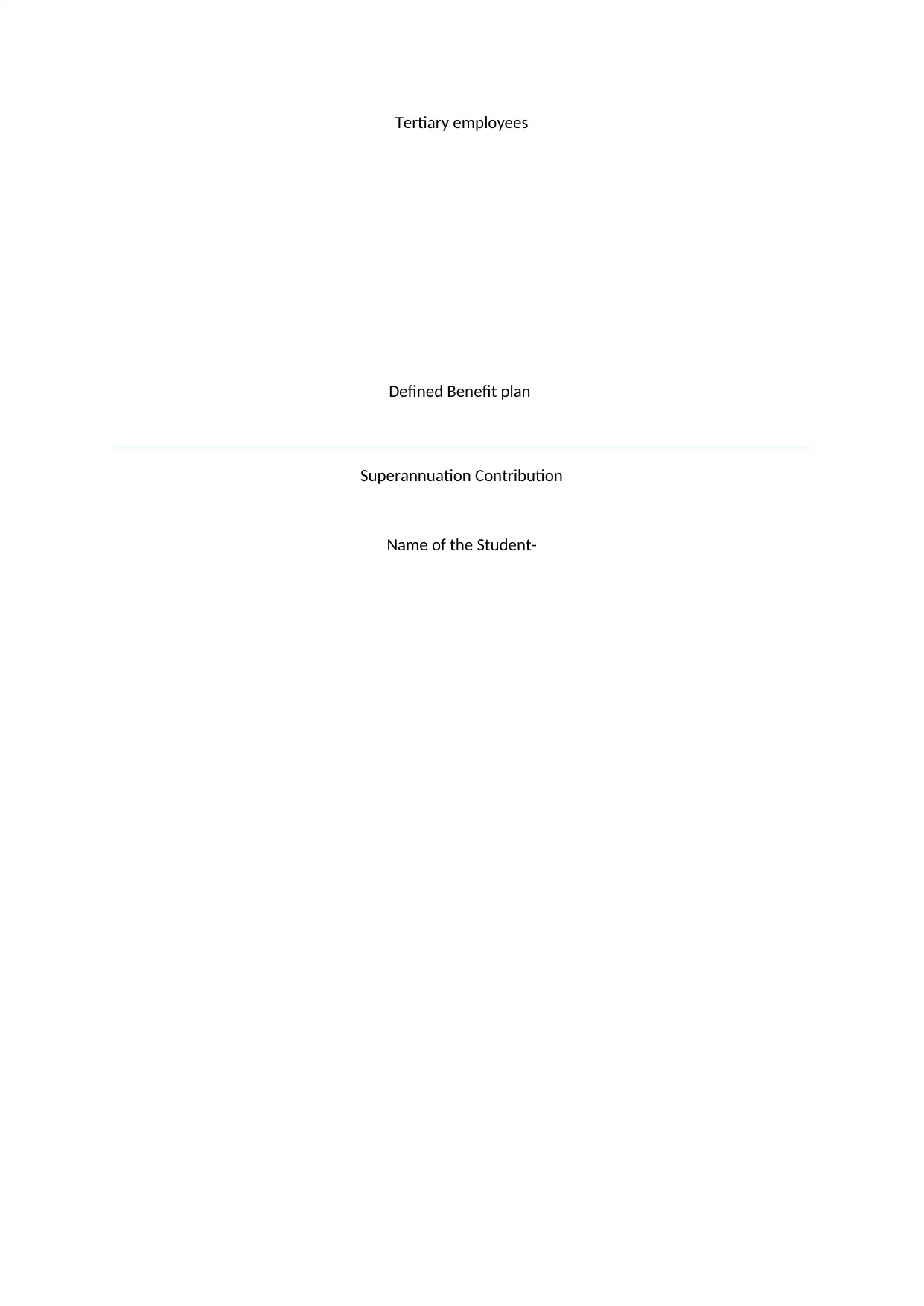
Tertiary employees
Defined Benefit plan
Superannuation Contribution
Name of the Student-
Defined Benefit plan
Superannuation Contribution
Name of the Student-
Paraphrase This Document
Need a fresh take? Get an instant paraphrase of this document with our AI Paraphraser
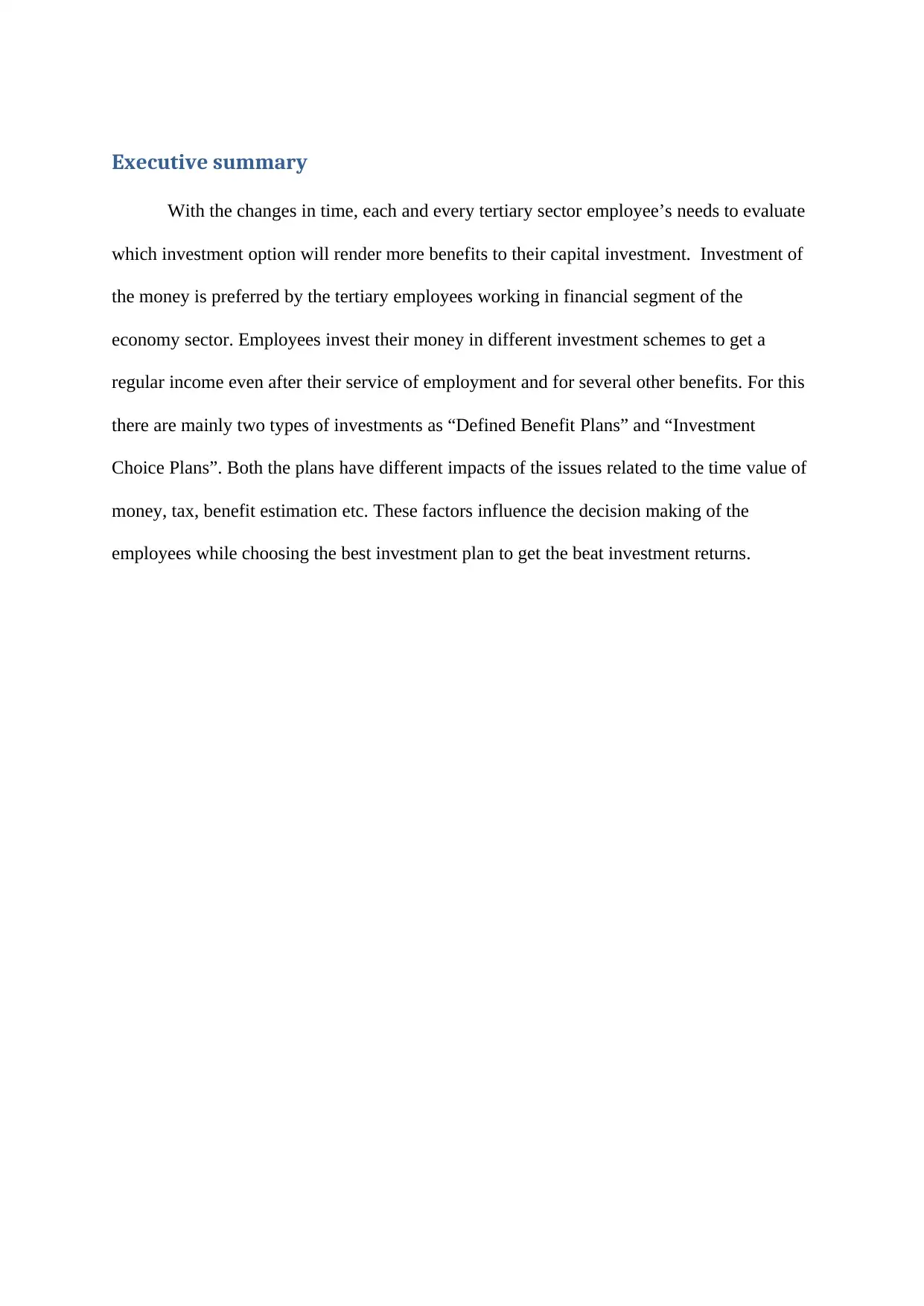
Executive summary
With the changes in time, each and every tertiary sector employee’s needs to evaluate
which investment option will render more benefits to their capital investment. Investment of
the money is preferred by the tertiary employees working in financial segment of the
economy sector. Employees invest their money in different investment schemes to get a
regular income even after their service of employment and for several other benefits. For this
there are mainly two types of investments as “Defined Benefit Plans” and “Investment
Choice Plans”. Both the plans have different impacts of the issues related to the time value of
money, tax, benefit estimation etc. These factors influence the decision making of the
employees while choosing the best investment plan to get the beat investment returns.
With the changes in time, each and every tertiary sector employee’s needs to evaluate
which investment option will render more benefits to their capital investment. Investment of
the money is preferred by the tertiary employees working in financial segment of the
economy sector. Employees invest their money in different investment schemes to get a
regular income even after their service of employment and for several other benefits. For this
there are mainly two types of investments as “Defined Benefit Plans” and “Investment
Choice Plans”. Both the plans have different impacts of the issues related to the time value of
money, tax, benefit estimation etc. These factors influence the decision making of the
employees while choosing the best investment plan to get the beat investment returns.
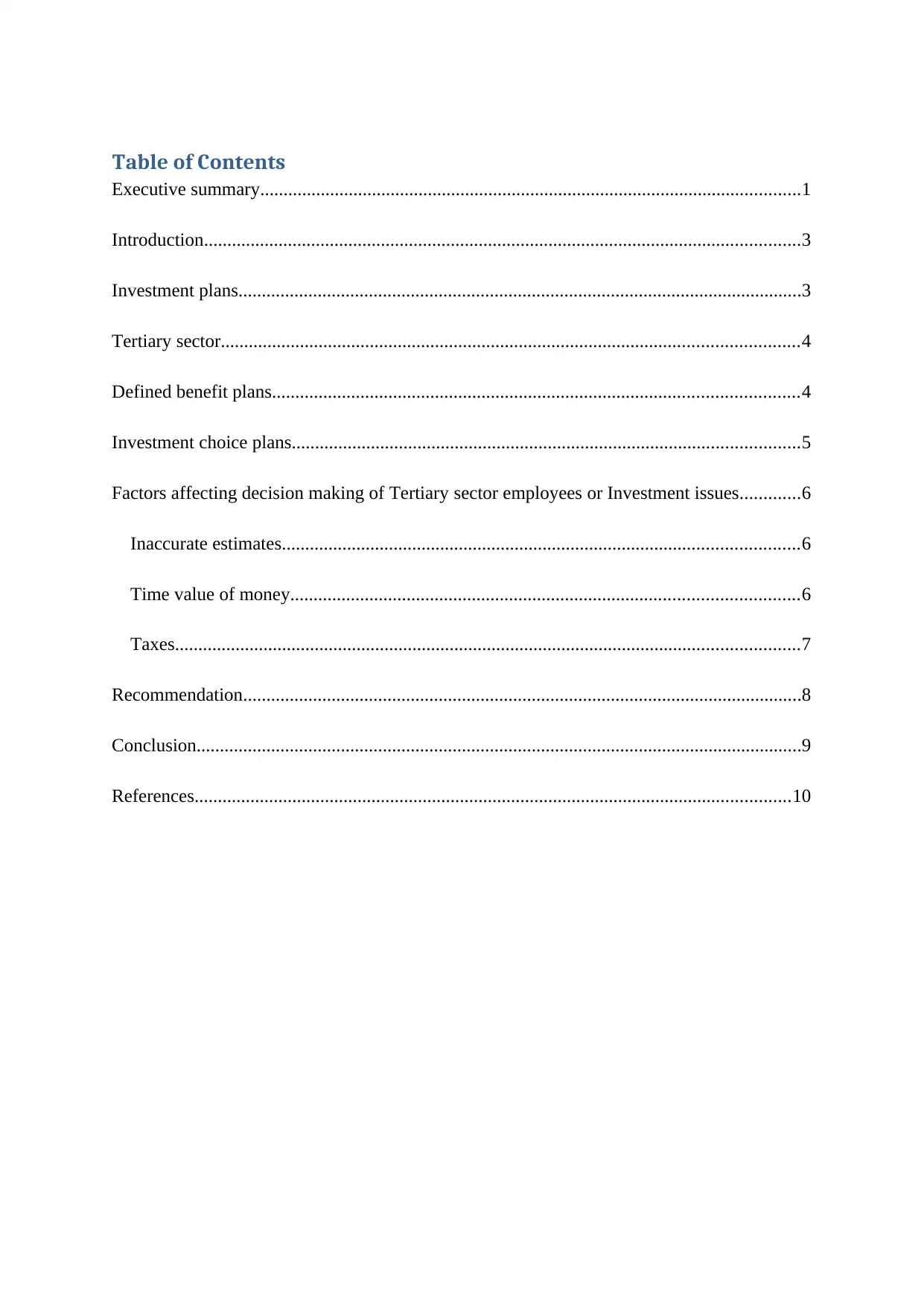
Table of Contents
Executive summary....................................................................................................................1
Introduction................................................................................................................................3
Investment plans.........................................................................................................................3
Tertiary sector............................................................................................................................4
Defined benefit plans.................................................................................................................4
Investment choice plans.............................................................................................................5
Factors affecting decision making of Tertiary sector employees or Investment issues.............6
Inaccurate estimates...............................................................................................................6
Time value of money.............................................................................................................6
Taxes......................................................................................................................................7
Recommendation........................................................................................................................8
Conclusion..................................................................................................................................9
References................................................................................................................................10
Executive summary....................................................................................................................1
Introduction................................................................................................................................3
Investment plans.........................................................................................................................3
Tertiary sector............................................................................................................................4
Defined benefit plans.................................................................................................................4
Investment choice plans.............................................................................................................5
Factors affecting decision making of Tertiary sector employees or Investment issues.............6
Inaccurate estimates...............................................................................................................6
Time value of money.............................................................................................................6
Taxes......................................................................................................................................7
Recommendation........................................................................................................................8
Conclusion..................................................................................................................................9
References................................................................................................................................10
⊘ This is a preview!⊘
Do you want full access?
Subscribe today to unlock all pages.

Trusted by 1+ million students worldwide
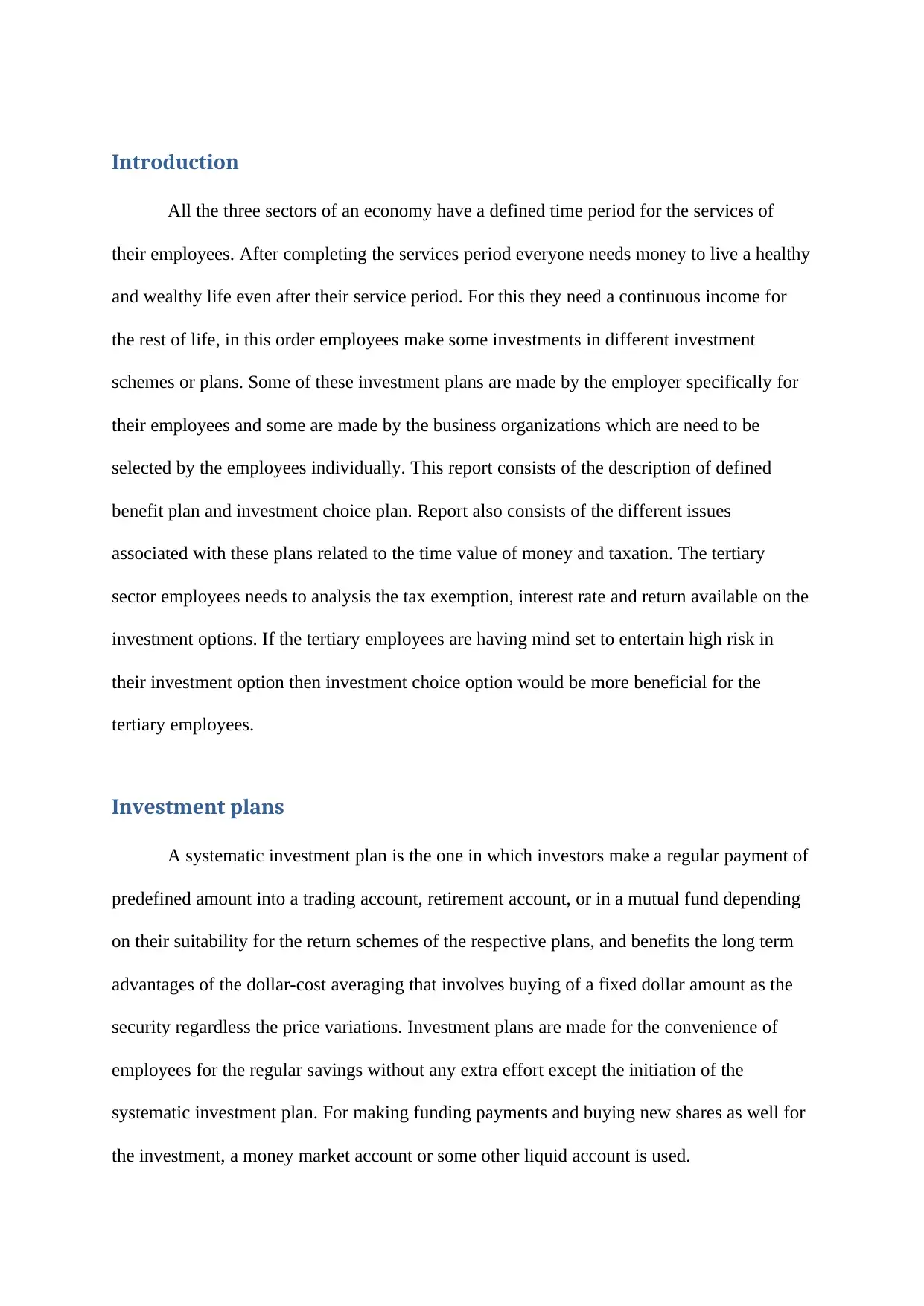
Introduction
All the three sectors of an economy have a defined time period for the services of
their employees. After completing the services period everyone needs money to live a healthy
and wealthy life even after their service period. For this they need a continuous income for
the rest of life, in this order employees make some investments in different investment
schemes or plans. Some of these investment plans are made by the employer specifically for
their employees and some are made by the business organizations which are need to be
selected by the employees individually. This report consists of the description of defined
benefit plan and investment choice plan. Report also consists of the different issues
associated with these plans related to the time value of money and taxation. The tertiary
sector employees needs to analysis the tax exemption, interest rate and return available on the
investment options. If the tertiary employees are having mind set to entertain high risk in
their investment option then investment choice option would be more beneficial for the
tertiary employees.
Investment plans
A systematic investment plan is the one in which investors make a regular payment of
predefined amount into a trading account, retirement account, or in a mutual fund depending
on their suitability for the return schemes of the respective plans, and benefits the long term
advantages of the dollar-cost averaging that involves buying of a fixed dollar amount as the
security regardless the price variations. Investment plans are made for the convenience of
employees for the regular savings without any extra effort except the initiation of the
systematic investment plan. For making funding payments and buying new shares as well for
the investment, a money market account or some other liquid account is used.
All the three sectors of an economy have a defined time period for the services of
their employees. After completing the services period everyone needs money to live a healthy
and wealthy life even after their service period. For this they need a continuous income for
the rest of life, in this order employees make some investments in different investment
schemes or plans. Some of these investment plans are made by the employer specifically for
their employees and some are made by the business organizations which are need to be
selected by the employees individually. This report consists of the description of defined
benefit plan and investment choice plan. Report also consists of the different issues
associated with these plans related to the time value of money and taxation. The tertiary
sector employees needs to analysis the tax exemption, interest rate and return available on the
investment options. If the tertiary employees are having mind set to entertain high risk in
their investment option then investment choice option would be more beneficial for the
tertiary employees.
Investment plans
A systematic investment plan is the one in which investors make a regular payment of
predefined amount into a trading account, retirement account, or in a mutual fund depending
on their suitability for the return schemes of the respective plans, and benefits the long term
advantages of the dollar-cost averaging that involves buying of a fixed dollar amount as the
security regardless the price variations. Investment plans are made for the convenience of
employees for the regular savings without any extra effort except the initiation of the
systematic investment plan. For making funding payments and buying new shares as well for
the investment, a money market account or some other liquid account is used.
Paraphrase This Document
Need a fresh take? Get an instant paraphrase of this document with our AI Paraphraser
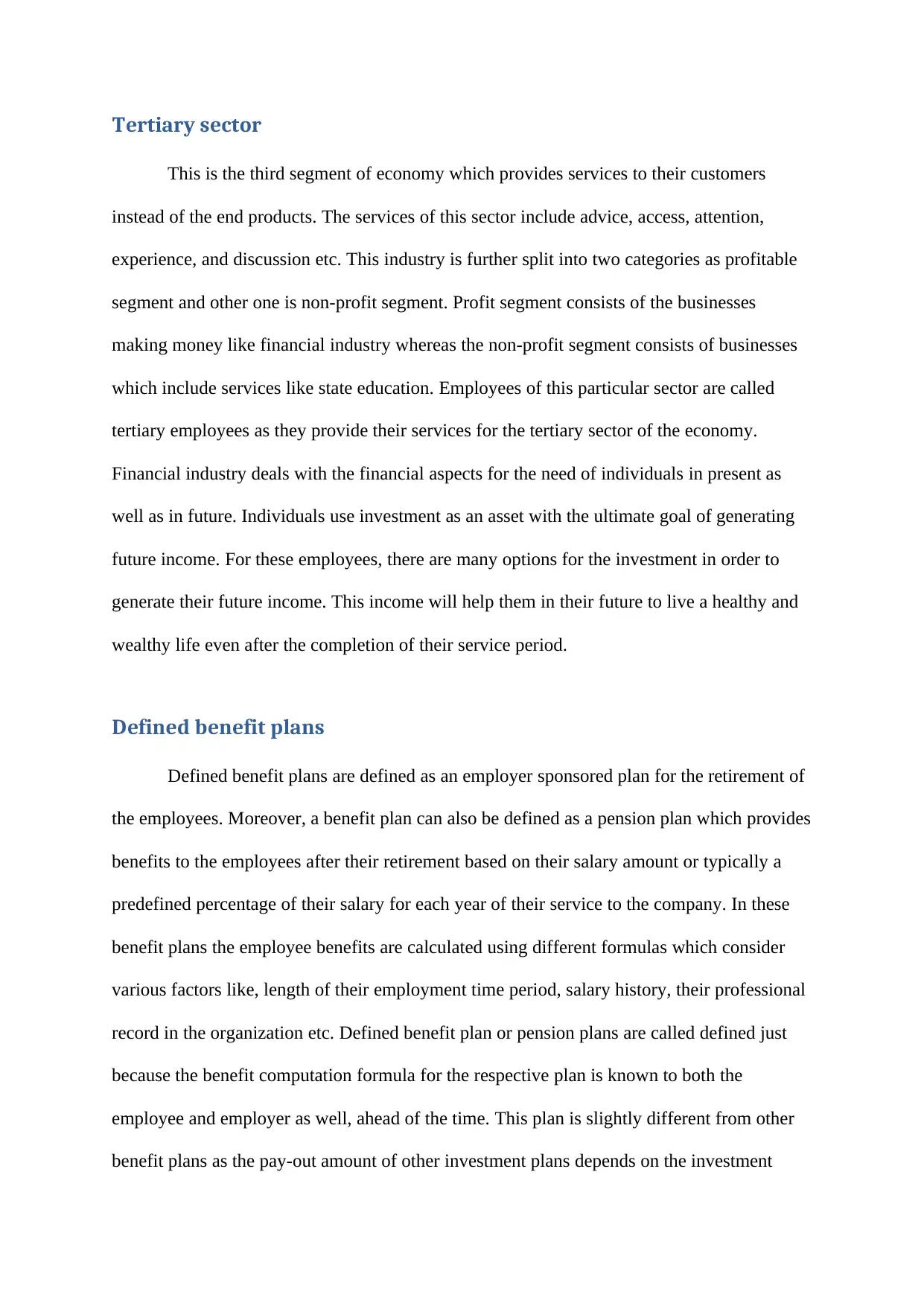
Tertiary sector
This is the third segment of economy which provides services to their customers
instead of the end products. The services of this sector include advice, access, attention,
experience, and discussion etc. This industry is further split into two categories as profitable
segment and other one is non-profit segment. Profit segment consists of the businesses
making money like financial industry whereas the non-profit segment consists of businesses
which include services like state education. Employees of this particular sector are called
tertiary employees as they provide their services for the tertiary sector of the economy.
Financial industry deals with the financial aspects for the need of individuals in present as
well as in future. Individuals use investment as an asset with the ultimate goal of generating
future income. For these employees, there are many options for the investment in order to
generate their future income. This income will help them in their future to live a healthy and
wealthy life even after the completion of their service period.
Defined benefit plans
Defined benefit plans are defined as an employer sponsored plan for the retirement of
the employees. Moreover, a benefit plan can also be defined as a pension plan which provides
benefits to the employees after their retirement based on their salary amount or typically a
predefined percentage of their salary for each year of their service to the company. In these
benefit plans the employee benefits are calculated using different formulas which consider
various factors like, length of their employment time period, salary history, their professional
record in the organization etc. Defined benefit plan or pension plans are called defined just
because the benefit computation formula for the respective plan is known to both the
employee and employer as well, ahead of the time. This plan is slightly different from other
benefit plans as the pay-out amount of other investment plans depends on the investment
This is the third segment of economy which provides services to their customers
instead of the end products. The services of this sector include advice, access, attention,
experience, and discussion etc. This industry is further split into two categories as profitable
segment and other one is non-profit segment. Profit segment consists of the businesses
making money like financial industry whereas the non-profit segment consists of businesses
which include services like state education. Employees of this particular sector are called
tertiary employees as they provide their services for the tertiary sector of the economy.
Financial industry deals with the financial aspects for the need of individuals in present as
well as in future. Individuals use investment as an asset with the ultimate goal of generating
future income. For these employees, there are many options for the investment in order to
generate their future income. This income will help them in their future to live a healthy and
wealthy life even after the completion of their service period.
Defined benefit plans
Defined benefit plans are defined as an employer sponsored plan for the retirement of
the employees. Moreover, a benefit plan can also be defined as a pension plan which provides
benefits to the employees after their retirement based on their salary amount or typically a
predefined percentage of their salary for each year of their service to the company. In these
benefit plans the employee benefits are calculated using different formulas which consider
various factors like, length of their employment time period, salary history, their professional
record in the organization etc. Defined benefit plan or pension plans are called defined just
because the benefit computation formula for the respective plan is known to both the
employee and employer as well, ahead of the time. This plan is slightly different from other
benefit plans as the pay-out amount of other investment plans depends on the investment
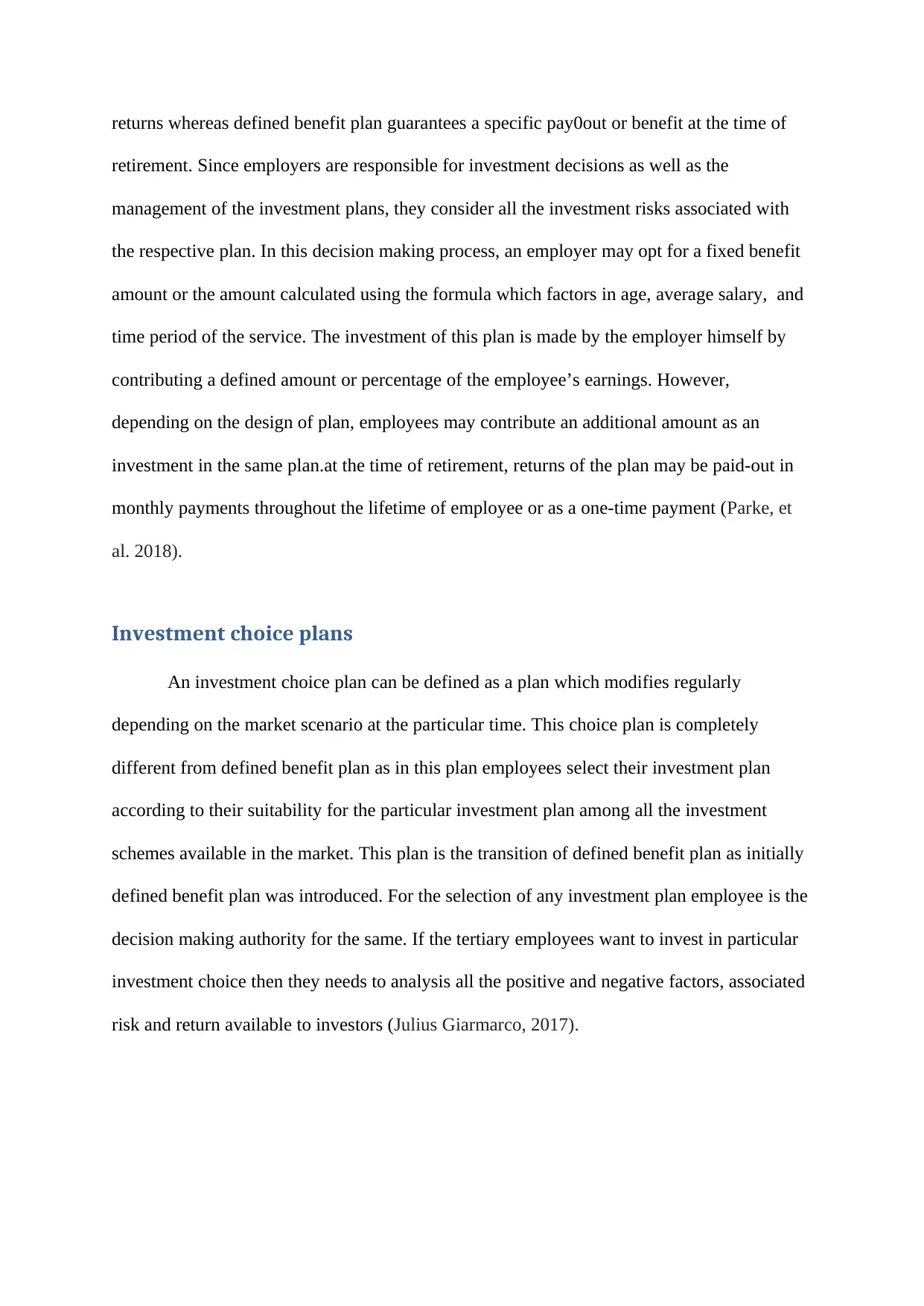
returns whereas defined benefit plan guarantees a specific pay0out or benefit at the time of
retirement. Since employers are responsible for investment decisions as well as the
management of the investment plans, they consider all the investment risks associated with
the respective plan. In this decision making process, an employer may opt for a fixed benefit
amount or the amount calculated using the formula which factors in age, average salary, and
time period of the service. The investment of this plan is made by the employer himself by
contributing a defined amount or percentage of the employee’s earnings. However,
depending on the design of plan, employees may contribute an additional amount as an
investment in the same plan.at the time of retirement, returns of the plan may be paid-out in
monthly payments throughout the lifetime of employee or as a one-time payment (Parke, et
al. 2018).
Investment choice plans
An investment choice plan can be defined as a plan which modifies regularly
depending on the market scenario at the particular time. This choice plan is completely
different from defined benefit plan as in this plan employees select their investment plan
according to their suitability for the particular investment plan among all the investment
schemes available in the market. This plan is the transition of defined benefit plan as initially
defined benefit plan was introduced. For the selection of any investment plan employee is the
decision making authority for the same. If the tertiary employees want to invest in particular
investment choice then they needs to analysis all the positive and negative factors, associated
risk and return available to investors (Julius Giarmarco, 2017).
retirement. Since employers are responsible for investment decisions as well as the
management of the investment plans, they consider all the investment risks associated with
the respective plan. In this decision making process, an employer may opt for a fixed benefit
amount or the amount calculated using the formula which factors in age, average salary, and
time period of the service. The investment of this plan is made by the employer himself by
contributing a defined amount or percentage of the employee’s earnings. However,
depending on the design of plan, employees may contribute an additional amount as an
investment in the same plan.at the time of retirement, returns of the plan may be paid-out in
monthly payments throughout the lifetime of employee or as a one-time payment (Parke, et
al. 2018).
Investment choice plans
An investment choice plan can be defined as a plan which modifies regularly
depending on the market scenario at the particular time. This choice plan is completely
different from defined benefit plan as in this plan employees select their investment plan
according to their suitability for the particular investment plan among all the investment
schemes available in the market. This plan is the transition of defined benefit plan as initially
defined benefit plan was introduced. For the selection of any investment plan employee is the
decision making authority for the same. If the tertiary employees want to invest in particular
investment choice then they needs to analysis all the positive and negative factors, associated
risk and return available to investors (Julius Giarmarco, 2017).
⊘ This is a preview!⊘
Do you want full access?
Subscribe today to unlock all pages.

Trusted by 1+ million students worldwide
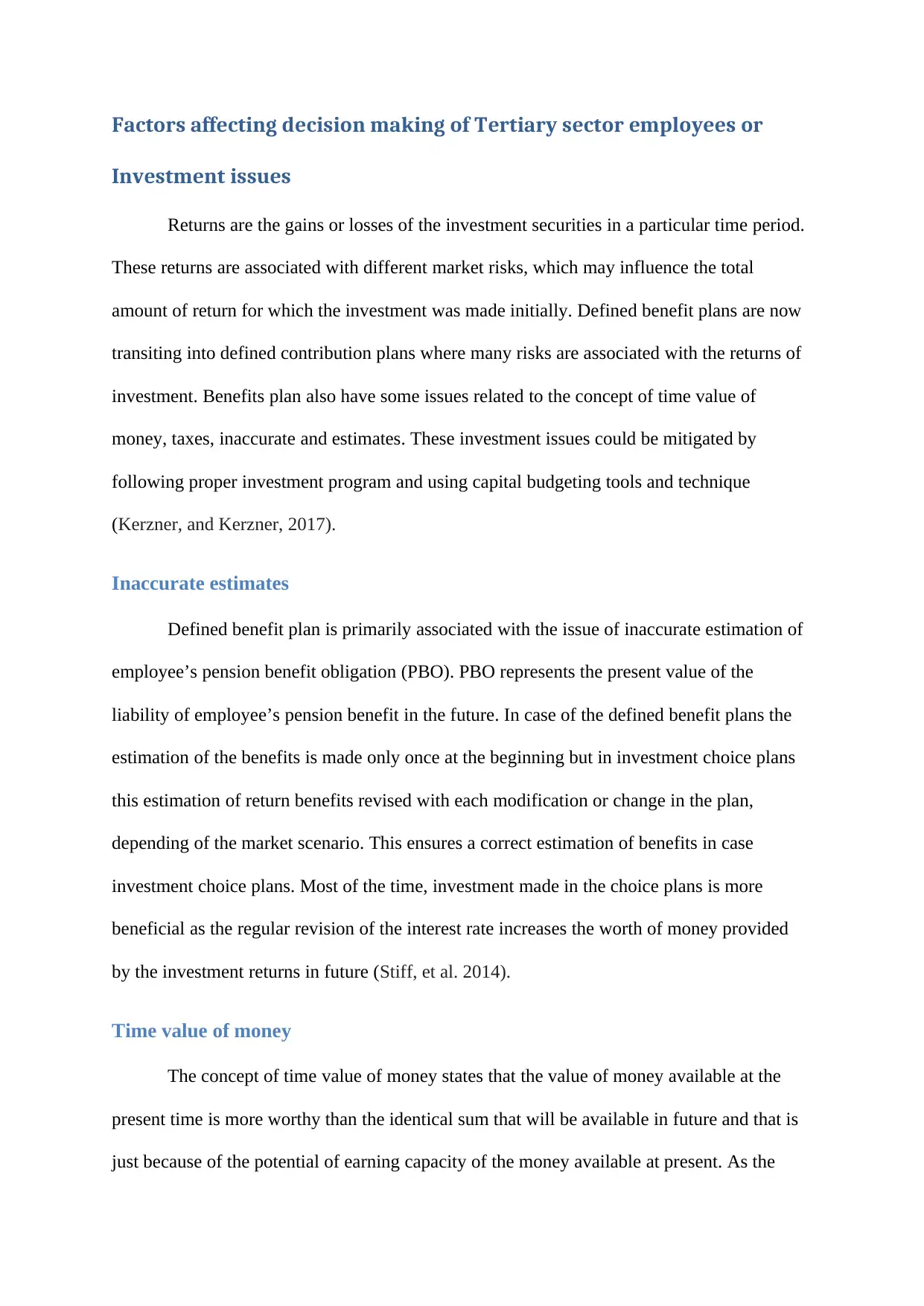
Factors affecting decision making of Tertiary sector employees or
Investment issues
Returns are the gains or losses of the investment securities in a particular time period.
These returns are associated with different market risks, which may influence the total
amount of return for which the investment was made initially. Defined benefit plans are now
transiting into defined contribution plans where many risks are associated with the returns of
investment. Benefits plan also have some issues related to the concept of time value of
money, taxes, inaccurate and estimates. These investment issues could be mitigated by
following proper investment program and using capital budgeting tools and technique
(Kerzner, and Kerzner, 2017).
Inaccurate estimates
Defined benefit plan is primarily associated with the issue of inaccurate estimation of
employee’s pension benefit obligation (PBO). PBO represents the present value of the
liability of employee’s pension benefit in the future. In case of the defined benefit plans the
estimation of the benefits is made only once at the beginning but in investment choice plans
this estimation of return benefits revised with each modification or change in the plan,
depending of the market scenario. This ensures a correct estimation of benefits in case
investment choice plans. Most of the time, investment made in the choice plans is more
beneficial as the regular revision of the interest rate increases the worth of money provided
by the investment returns in future (Stiff, et al. 2014).
Time value of money
The concept of time value of money states that the value of money available at the
present time is more worthy than the identical sum that will be available in future and that is
just because of the potential of earning capacity of the money available at present. As the
Investment issues
Returns are the gains or losses of the investment securities in a particular time period.
These returns are associated with different market risks, which may influence the total
amount of return for which the investment was made initially. Defined benefit plans are now
transiting into defined contribution plans where many risks are associated with the returns of
investment. Benefits plan also have some issues related to the concept of time value of
money, taxes, inaccurate and estimates. These investment issues could be mitigated by
following proper investment program and using capital budgeting tools and technique
(Kerzner, and Kerzner, 2017).
Inaccurate estimates
Defined benefit plan is primarily associated with the issue of inaccurate estimation of
employee’s pension benefit obligation (PBO). PBO represents the present value of the
liability of employee’s pension benefit in the future. In case of the defined benefit plans the
estimation of the benefits is made only once at the beginning but in investment choice plans
this estimation of return benefits revised with each modification or change in the plan,
depending of the market scenario. This ensures a correct estimation of benefits in case
investment choice plans. Most of the time, investment made in the choice plans is more
beneficial as the regular revision of the interest rate increases the worth of money provided
by the investment returns in future (Stiff, et al. 2014).
Time value of money
The concept of time value of money states that the value of money available at the
present time is more worthy than the identical sum that will be available in future and that is
just because of the potential of earning capacity of the money available at present. As the
Paraphrase This Document
Need a fresh take? Get an instant paraphrase of this document with our AI Paraphraser
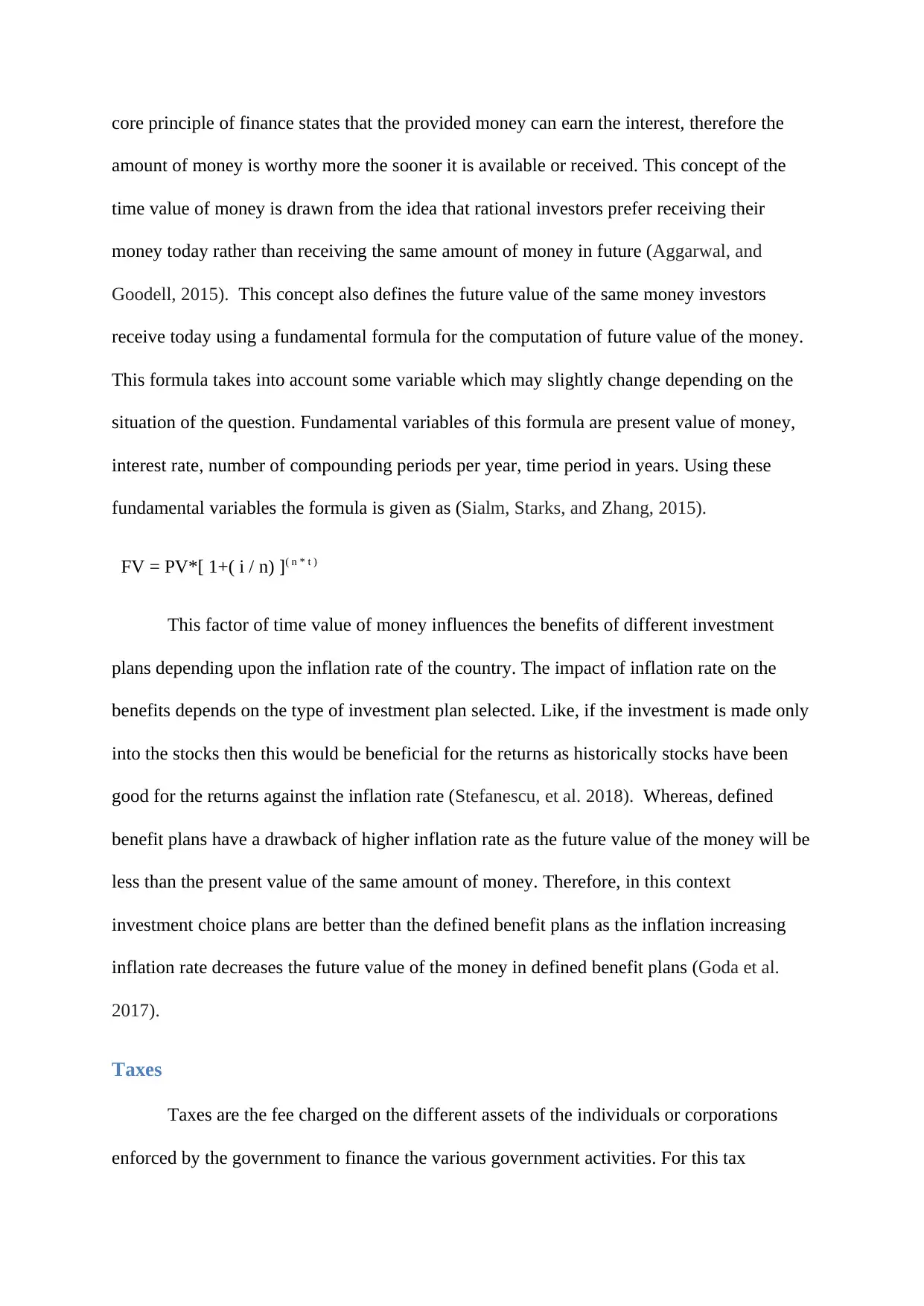
core principle of finance states that the provided money can earn the interest, therefore the
amount of money is worthy more the sooner it is available or received. This concept of the
time value of money is drawn from the idea that rational investors prefer receiving their
money today rather than receiving the same amount of money in future (Aggarwal, and
Goodell, 2015). This concept also defines the future value of the same money investors
receive today using a fundamental formula for the computation of future value of the money.
This formula takes into account some variable which may slightly change depending on the
situation of the question. Fundamental variables of this formula are present value of money,
interest rate, number of compounding periods per year, time period in years. Using these
fundamental variables the formula is given as (Sialm, Starks, and Zhang, 2015).
FV = PV*[ 1+( i / n) ]( n * t )
This factor of time value of money influences the benefits of different investment
plans depending upon the inflation rate of the country. The impact of inflation rate on the
benefits depends on the type of investment plan selected. Like, if the investment is made only
into the stocks then this would be beneficial for the returns as historically stocks have been
good for the returns against the inflation rate (Stefanescu, et al. 2018). Whereas, defined
benefit plans have a drawback of higher inflation rate as the future value of the money will be
less than the present value of the same amount of money. Therefore, in this context
investment choice plans are better than the defined benefit plans as the inflation increasing
inflation rate decreases the future value of the money in defined benefit plans (Goda et al.
2017).
Taxes
Taxes are the fee charged on the different assets of the individuals or corporations
enforced by the government to finance the various government activities. For this tax
amount of money is worthy more the sooner it is available or received. This concept of the
time value of money is drawn from the idea that rational investors prefer receiving their
money today rather than receiving the same amount of money in future (Aggarwal, and
Goodell, 2015). This concept also defines the future value of the same money investors
receive today using a fundamental formula for the computation of future value of the money.
This formula takes into account some variable which may slightly change depending on the
situation of the question. Fundamental variables of this formula are present value of money,
interest rate, number of compounding periods per year, time period in years. Using these
fundamental variables the formula is given as (Sialm, Starks, and Zhang, 2015).
FV = PV*[ 1+( i / n) ]( n * t )
This factor of time value of money influences the benefits of different investment
plans depending upon the inflation rate of the country. The impact of inflation rate on the
benefits depends on the type of investment plan selected. Like, if the investment is made only
into the stocks then this would be beneficial for the returns as historically stocks have been
good for the returns against the inflation rate (Stefanescu, et al. 2018). Whereas, defined
benefit plans have a drawback of higher inflation rate as the future value of the money will be
less than the present value of the same amount of money. Therefore, in this context
investment choice plans are better than the defined benefit plans as the inflation increasing
inflation rate decreases the future value of the money in defined benefit plans (Goda et al.
2017).
Taxes
Taxes are the fee charged on the different assets of the individuals or corporations
enforced by the government to finance the various government activities. For this tax
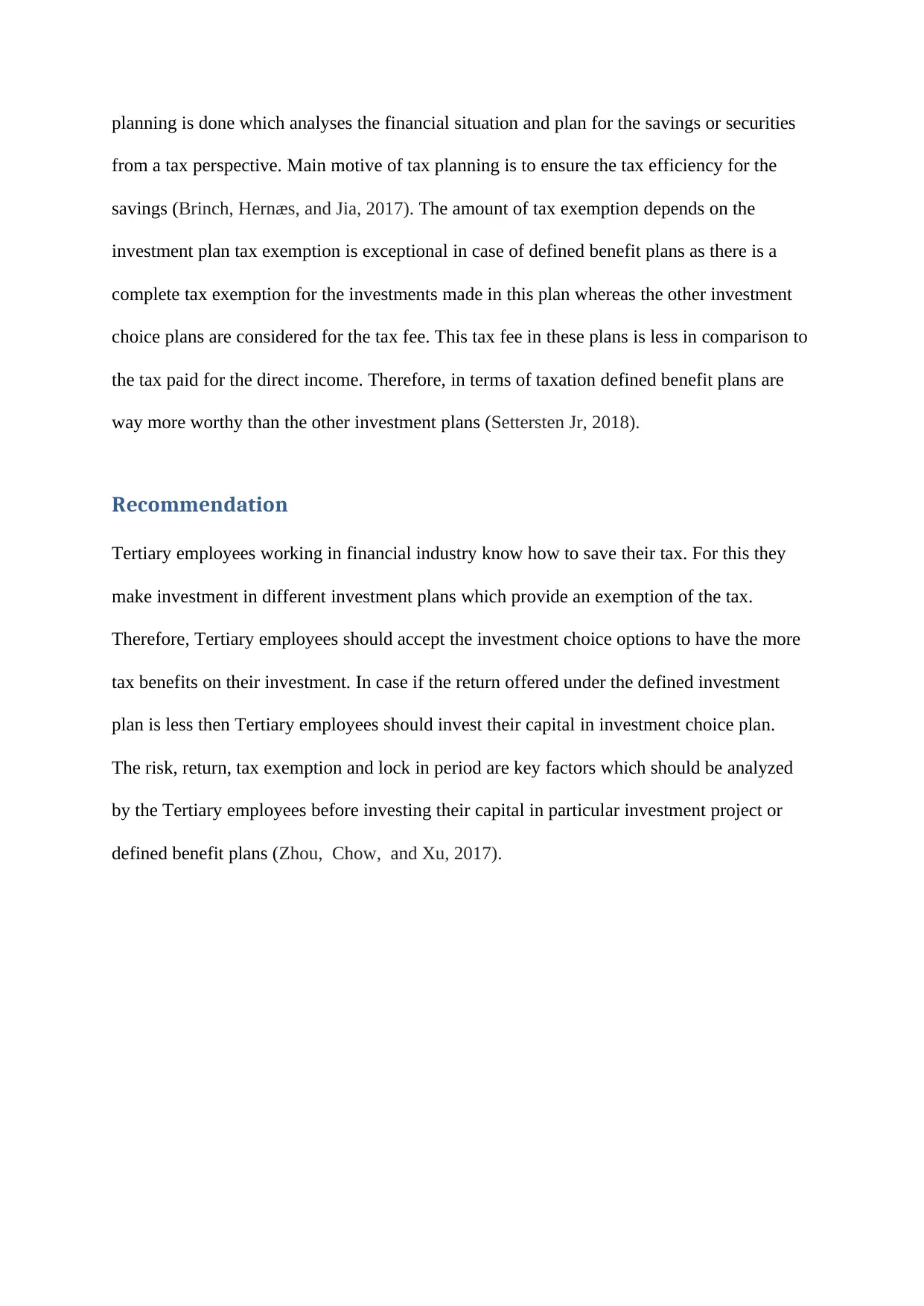
planning is done which analyses the financial situation and plan for the savings or securities
from a tax perspective. Main motive of tax planning is to ensure the tax efficiency for the
savings (Brinch, Hernæs, and Jia, 2017). The amount of tax exemption depends on the
investment plan tax exemption is exceptional in case of defined benefit plans as there is a
complete tax exemption for the investments made in this plan whereas the other investment
choice plans are considered for the tax fee. This tax fee in these plans is less in comparison to
the tax paid for the direct income. Therefore, in terms of taxation defined benefit plans are
way more worthy than the other investment plans (Settersten Jr, 2018).
Recommendation
Tertiary employees working in financial industry know how to save their tax. For this they
make investment in different investment plans which provide an exemption of the tax.
Therefore, Tertiary employees should accept the investment choice options to have the more
tax benefits on their investment. In case if the return offered under the defined investment
plan is less then Tertiary employees should invest their capital in investment choice plan.
The risk, return, tax exemption and lock in period are key factors which should be analyzed
by the Tertiary employees before investing their capital in particular investment project or
defined benefit plans (Zhou, Chow, and Xu, 2017).
from a tax perspective. Main motive of tax planning is to ensure the tax efficiency for the
savings (Brinch, Hernæs, and Jia, 2017). The amount of tax exemption depends on the
investment plan tax exemption is exceptional in case of defined benefit plans as there is a
complete tax exemption for the investments made in this plan whereas the other investment
choice plans are considered for the tax fee. This tax fee in these plans is less in comparison to
the tax paid for the direct income. Therefore, in terms of taxation defined benefit plans are
way more worthy than the other investment plans (Settersten Jr, 2018).
Recommendation
Tertiary employees working in financial industry know how to save their tax. For this they
make investment in different investment plans which provide an exemption of the tax.
Therefore, Tertiary employees should accept the investment choice options to have the more
tax benefits on their investment. In case if the return offered under the defined investment
plan is less then Tertiary employees should invest their capital in investment choice plan.
The risk, return, tax exemption and lock in period are key factors which should be analyzed
by the Tertiary employees before investing their capital in particular investment project or
defined benefit plans (Zhou, Chow, and Xu, 2017).
⊘ This is a preview!⊘
Do you want full access?
Subscribe today to unlock all pages.

Trusted by 1+ million students worldwide
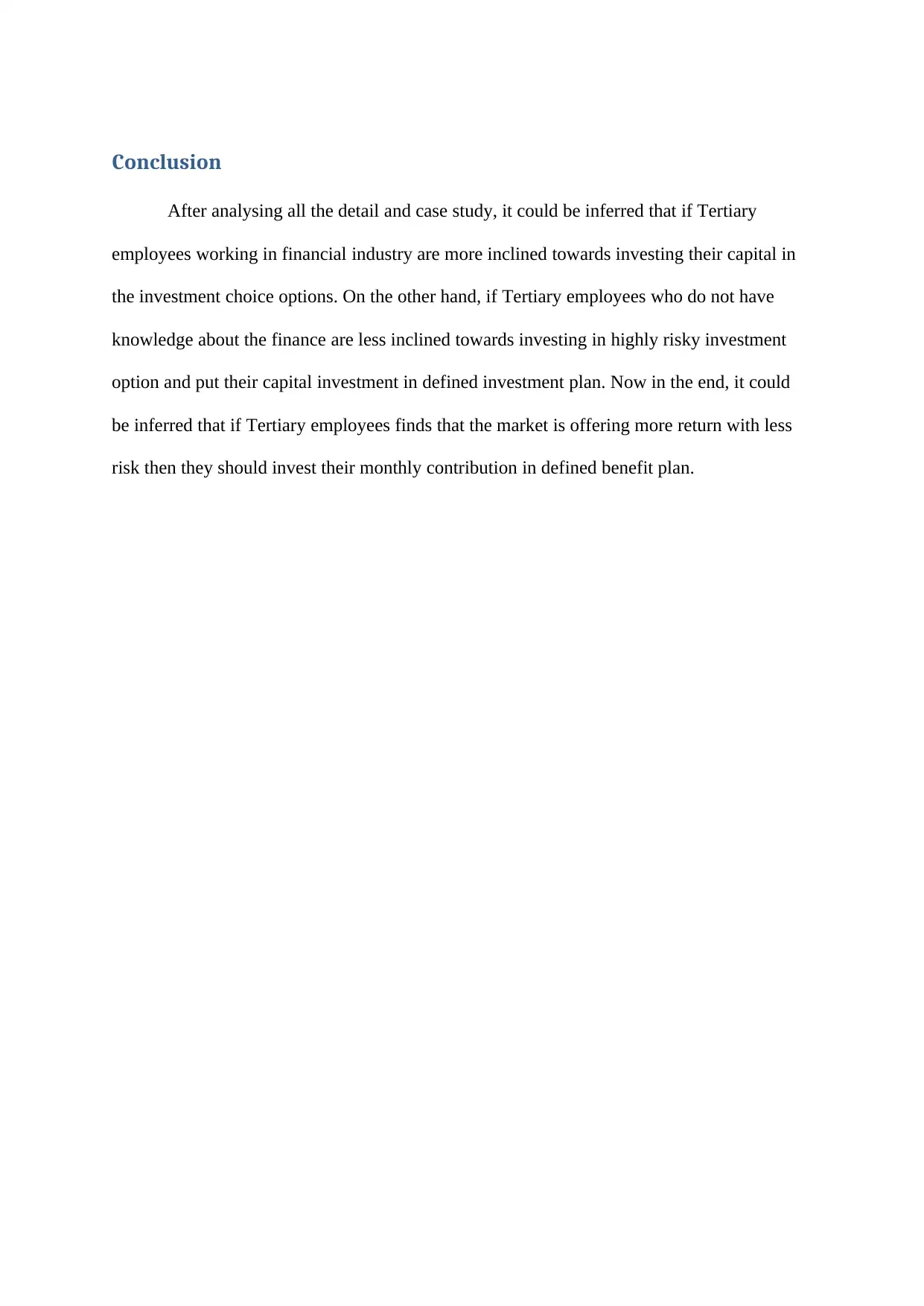
Conclusion
After analysing all the detail and case study, it could be inferred that if Tertiary
employees working in financial industry are more inclined towards investing their capital in
the investment choice options. On the other hand, if Tertiary employees who do not have
knowledge about the finance are less inclined towards investing in highly risky investment
option and put their capital investment in defined investment plan. Now in the end, it could
be inferred that if Tertiary employees finds that the market is offering more return with less
risk then they should invest their monthly contribution in defined benefit plan.
After analysing all the detail and case study, it could be inferred that if Tertiary
employees working in financial industry are more inclined towards investing their capital in
the investment choice options. On the other hand, if Tertiary employees who do not have
knowledge about the finance are less inclined towards investing in highly risky investment
option and put their capital investment in defined investment plan. Now in the end, it could
be inferred that if Tertiary employees finds that the market is offering more return with less
risk then they should invest their monthly contribution in defined benefit plan.
Paraphrase This Document
Need a fresh take? Get an instant paraphrase of this document with our AI Paraphraser
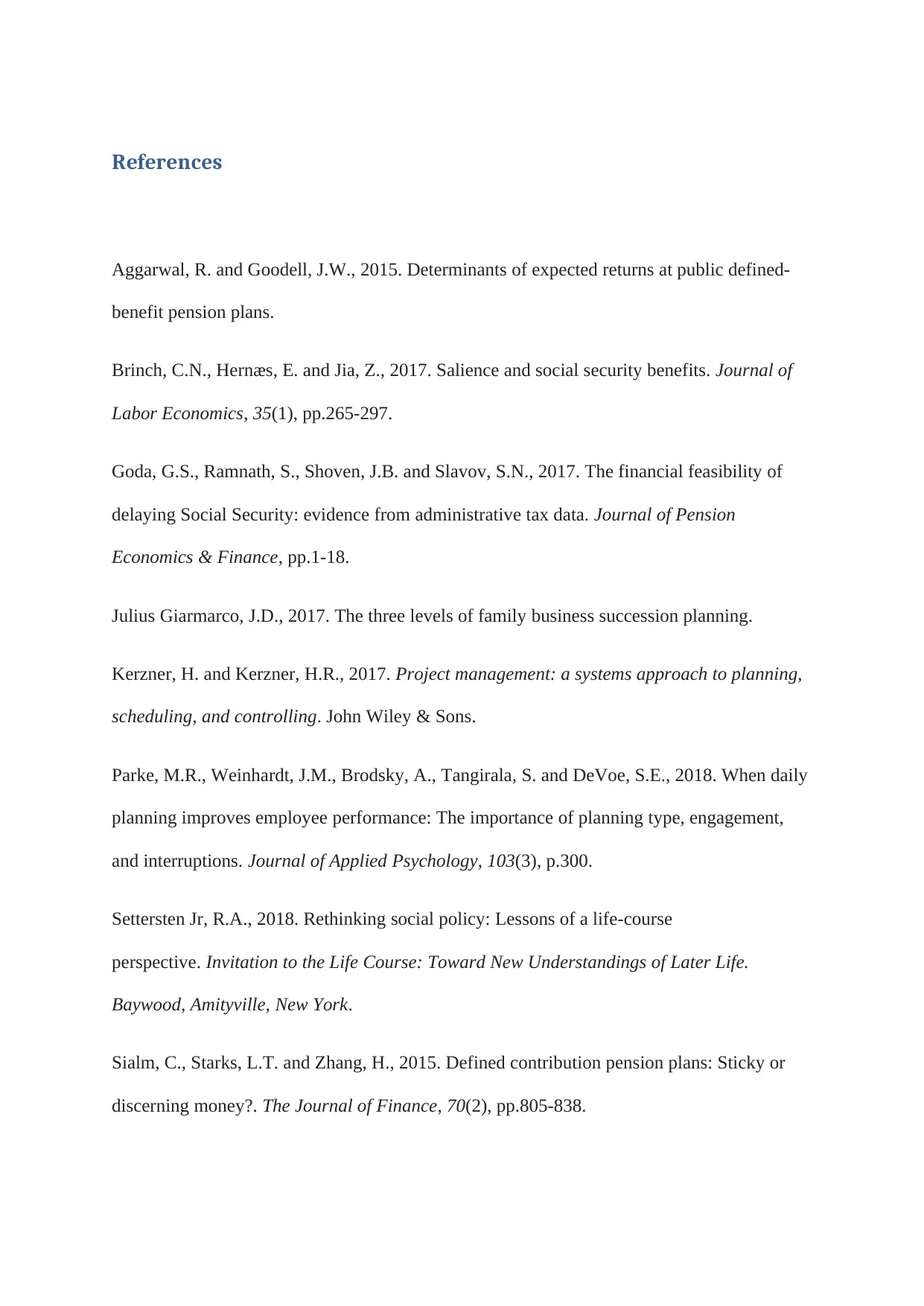
References
Aggarwal, R. and Goodell, J.W., 2015. Determinants of expected returns at public defined-
benefit pension plans.
Brinch, C.N., Hernæs, E. and Jia, Z., 2017. Salience and social security benefits. Journal of
Labor Economics, 35(1), pp.265-297.
Goda, G.S., Ramnath, S., Shoven, J.B. and Slavov, S.N., 2017. The financial feasibility of
delaying Social Security: evidence from administrative tax data. Journal of Pension
Economics & Finance, pp.1-18.
Julius Giarmarco, J.D., 2017. The three levels of family business succession planning.
Kerzner, H. and Kerzner, H.R., 2017. Project management: a systems approach to planning,
scheduling, and controlling. John Wiley & Sons.
Parke, M.R., Weinhardt, J.M., Brodsky, A., Tangirala, S. and DeVoe, S.E., 2018. When daily
planning improves employee performance: The importance of planning type, engagement,
and interruptions. Journal of Applied Psychology, 103(3), p.300.
Settersten Jr, R.A., 2018. Rethinking social policy: Lessons of a life-course
perspective. Invitation to the Life Course: Toward New Understandings of Later Life.
Baywood, Amityville, New York.
Sialm, C., Starks, L.T. and Zhang, H., 2015. Defined contribution pension plans: Sticky or
discerning money?. The Journal of Finance, 70(2), pp.805-838.
Aggarwal, R. and Goodell, J.W., 2015. Determinants of expected returns at public defined-
benefit pension plans.
Brinch, C.N., Hernæs, E. and Jia, Z., 2017. Salience and social security benefits. Journal of
Labor Economics, 35(1), pp.265-297.
Goda, G.S., Ramnath, S., Shoven, J.B. and Slavov, S.N., 2017. The financial feasibility of
delaying Social Security: evidence from administrative tax data. Journal of Pension
Economics & Finance, pp.1-18.
Julius Giarmarco, J.D., 2017. The three levels of family business succession planning.
Kerzner, H. and Kerzner, H.R., 2017. Project management: a systems approach to planning,
scheduling, and controlling. John Wiley & Sons.
Parke, M.R., Weinhardt, J.M., Brodsky, A., Tangirala, S. and DeVoe, S.E., 2018. When daily
planning improves employee performance: The importance of planning type, engagement,
and interruptions. Journal of Applied Psychology, 103(3), p.300.
Settersten Jr, R.A., 2018. Rethinking social policy: Lessons of a life-course
perspective. Invitation to the Life Course: Toward New Understandings of Later Life.
Baywood, Amityville, New York.
Sialm, C., Starks, L.T. and Zhang, H., 2015. Defined contribution pension plans: Sticky or
discerning money?. The Journal of Finance, 70(2), pp.805-838.
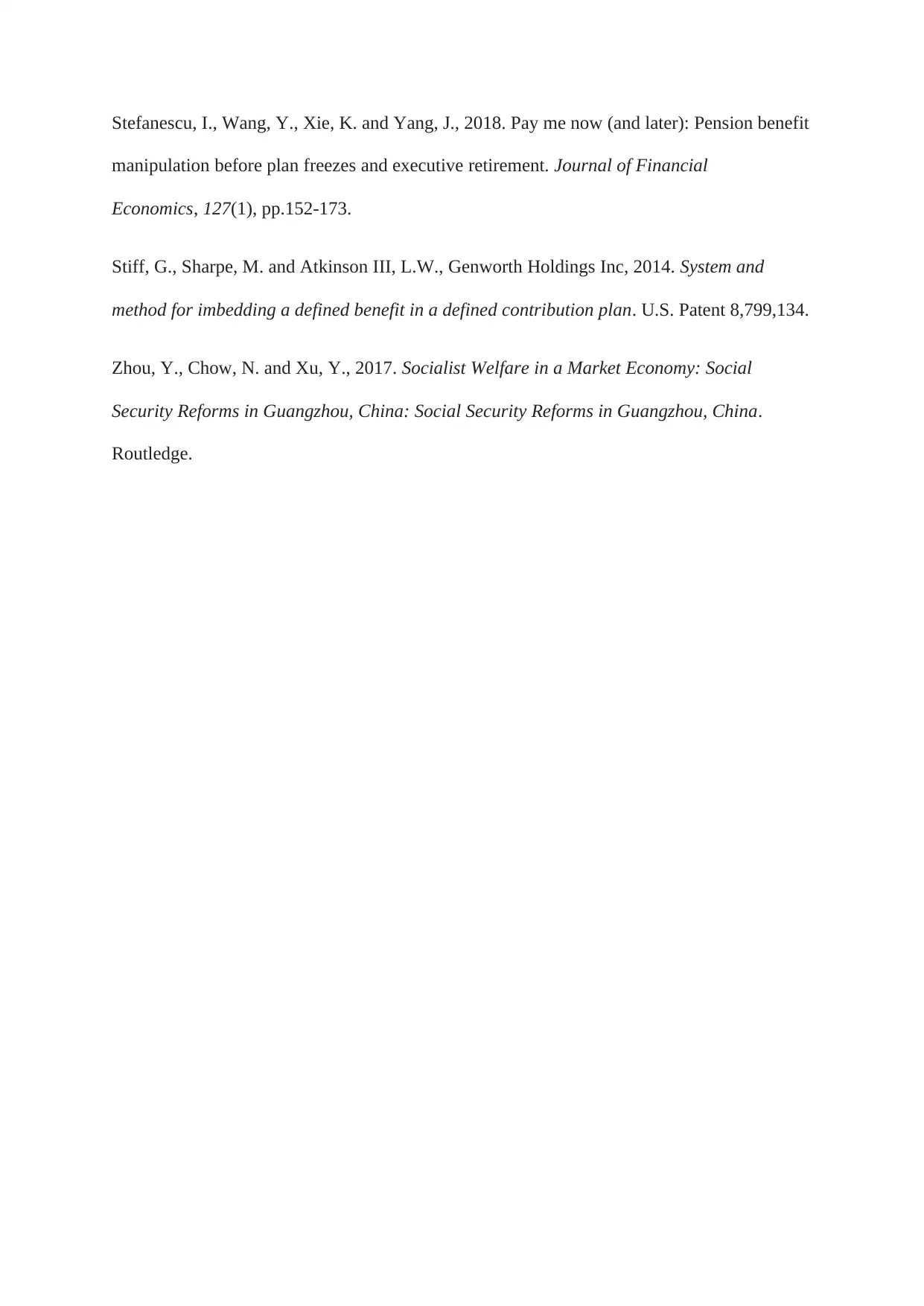
Stefanescu, I., Wang, Y., Xie, K. and Yang, J., 2018. Pay me now (and later): Pension benefit
manipulation before plan freezes and executive retirement. Journal of Financial
Economics, 127(1), pp.152-173.
Stiff, G., Sharpe, M. and Atkinson III, L.W., Genworth Holdings Inc, 2014. System and
method for imbedding a defined benefit in a defined contribution plan. U.S. Patent 8,799,134.
Zhou, Y., Chow, N. and Xu, Y., 2017. Socialist Welfare in a Market Economy: Social
Security Reforms in Guangzhou, China: Social Security Reforms in Guangzhou, China.
Routledge.
manipulation before plan freezes and executive retirement. Journal of Financial
Economics, 127(1), pp.152-173.
Stiff, G., Sharpe, M. and Atkinson III, L.W., Genworth Holdings Inc, 2014. System and
method for imbedding a defined benefit in a defined contribution plan. U.S. Patent 8,799,134.
Zhou, Y., Chow, N. and Xu, Y., 2017. Socialist Welfare in a Market Economy: Social
Security Reforms in Guangzhou, China: Social Security Reforms in Guangzhou, China.
Routledge.
⊘ This is a preview!⊘
Do you want full access?
Subscribe today to unlock all pages.

Trusted by 1+ million students worldwide
1 out of 12
Related Documents
Your All-in-One AI-Powered Toolkit for Academic Success.
+13062052269
info@desklib.com
Available 24*7 on WhatsApp / Email
![[object Object]](/_next/static/media/star-bottom.7253800d.svg)
Unlock your academic potential
Copyright © 2020–2025 A2Z Services. All Rights Reserved. Developed and managed by ZUCOL.





